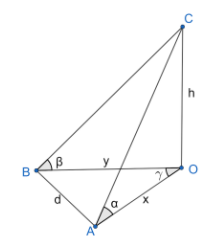
A vertical pole stands at a point O on a horizontal ground. A and B are points on the ground d meters apart. The pole subtends angles \[\alpha \] and \[\beta \] at A and B respectively. AB subtends an angle \[\gamma \] at O, the height of the pole is
Answer
569.1k+ views
Hint:
The formula for writing tangent of an angle is
\[\tan \theta =\dfrac{perpendicular}{base}\] .
Another important formula that may be used in the question is the cosine rule which is
\[{{b}^{2}}={{a}^{2}}+{{c}^{2}}-2ac\cos B\]
(Where a, b and c are the side lengths of the triangle and B is the angle opposite to the side length b)
Complete step by step answer:
As mentioned in the question, the figure would look like the below picture

(Where the height of the vertical pole is taken to be as ‘h’)
Let the distance between A and O be x and the distance between B and O be y.
Now, firstly using the tangent formula in triangle with \[\alpha \] angle as follows
\[\begin{align}
& \tan \alpha =\dfrac{h}{x} \\
& x=h\cot \alpha \ \ \ \ \ ...(1) \\
\end{align}\]
Secondly, using the tangent formula again in the triangle with \[\beta \] angle as follows
\[\begin{align}
& \tan \beta =\dfrac{h}{y} \\
& y=h\cot \beta \ \ \ \ \ ...(2) \\
\end{align}\]
Now, using the cosine formula in the \[\vartriangle AOB\]as follows
\[{{d}^{2}}={{x}^{2}}+{{y}^{2}}-2xy\cos \gamma \ \ \ \ \ ...(a)\]
Now, putting equations (1) and (2) in equation (a) as follows, we get
\[\begin{align}
& {{d}^{2}}={{h}^{2}}{{\cot }^{2}}\alpha +{{h}^{2}}{{\cot }^{2}}\beta -2(h\cot \alpha )(h\cot \beta )\cos \gamma \\
& {{d}^{2}}={{h}^{2}}{{\cot }^{2}}\alpha +{{h}^{2}}{{\cot }^{2}}\beta -2{{h}^{2}}\cdot \cot \alpha \cdot \cot \beta \cdot \cos \gamma \\
& {{d}^{2}}={{h}^{2}}\left( {{\cot }^{2}}\alpha +{{\cot }^{2}}\beta -2\cot \alpha \cdot \cot \beta \cdot \cos \gamma \right) \\
& {{h}^{2}}=\dfrac{{{d}^{2}}}{\left( {{\cot }^{2}}\alpha +{{\cot }^{2}}\beta -2\cot \alpha \cdot \cot \beta \cdot \cos \gamma \right)} \\
\end{align}\]
Now, on taking square root on both the sides, we get the height of the vertical pole that is standing on point O is
\[h=\dfrac{d}{{{\left( {{\cot }^{2}}\alpha +{{\cot }^{2}}\beta -2\cot \alpha \cdot \cot \beta \cdot \cos \gamma \right)}^{\dfrac{1}{2}}}}\]
Note:
The figure in this question is very tricky and is difficult to visualize it at first. Hence, the students can make an error while drawing the figure and then end up making a mistake and they would get to the correct solution. We can also solve the sides of the triangle using sine rule and then convert into cosine form.
The formula for writing tangent of an angle is
\[\tan \theta =\dfrac{perpendicular}{base}\] .
Another important formula that may be used in the question is the cosine rule which is
\[{{b}^{2}}={{a}^{2}}+{{c}^{2}}-2ac\cos B\]
(Where a, b and c are the side lengths of the triangle and B is the angle opposite to the side length b)
Complete step by step answer:
As mentioned in the question, the figure would look like the below picture

(Where the height of the vertical pole is taken to be as ‘h’)
Let the distance between A and O be x and the distance between B and O be y.
Now, firstly using the tangent formula in triangle with \[\alpha \] angle as follows
\[\begin{align}
& \tan \alpha =\dfrac{h}{x} \\
& x=h\cot \alpha \ \ \ \ \ ...(1) \\
\end{align}\]
Secondly, using the tangent formula again in the triangle with \[\beta \] angle as follows
\[\begin{align}
& \tan \beta =\dfrac{h}{y} \\
& y=h\cot \beta \ \ \ \ \ ...(2) \\
\end{align}\]
Now, using the cosine formula in the \[\vartriangle AOB\]as follows
\[{{d}^{2}}={{x}^{2}}+{{y}^{2}}-2xy\cos \gamma \ \ \ \ \ ...(a)\]
Now, putting equations (1) and (2) in equation (a) as follows, we get
\[\begin{align}
& {{d}^{2}}={{h}^{2}}{{\cot }^{2}}\alpha +{{h}^{2}}{{\cot }^{2}}\beta -2(h\cot \alpha )(h\cot \beta )\cos \gamma \\
& {{d}^{2}}={{h}^{2}}{{\cot }^{2}}\alpha +{{h}^{2}}{{\cot }^{2}}\beta -2{{h}^{2}}\cdot \cot \alpha \cdot \cot \beta \cdot \cos \gamma \\
& {{d}^{2}}={{h}^{2}}\left( {{\cot }^{2}}\alpha +{{\cot }^{2}}\beta -2\cot \alpha \cdot \cot \beta \cdot \cos \gamma \right) \\
& {{h}^{2}}=\dfrac{{{d}^{2}}}{\left( {{\cot }^{2}}\alpha +{{\cot }^{2}}\beta -2\cot \alpha \cdot \cot \beta \cdot \cos \gamma \right)} \\
\end{align}\]
Now, on taking square root on both the sides, we get the height of the vertical pole that is standing on point O is
\[h=\dfrac{d}{{{\left( {{\cot }^{2}}\alpha +{{\cot }^{2}}\beta -2\cot \alpha \cdot \cot \beta \cdot \cos \gamma \right)}^{\dfrac{1}{2}}}}\]
Note:
The figure in this question is very tricky and is difficult to visualize it at first. Hence, the students can make an error while drawing the figure and then end up making a mistake and they would get to the correct solution. We can also solve the sides of the triangle using sine rule and then convert into cosine form.
Recently Updated Pages
Two men on either side of the cliff 90m height observe class 10 maths CBSE

What happens to glucose which enters nephron along class 10 biology CBSE

Cutting of the Chinese melon means A The business and class 10 social science CBSE

Write a dialogue with at least ten utterances between class 10 english CBSE

Show an aquatic food chain using the following organisms class 10 biology CBSE

A circle is inscribed in an equilateral triangle and class 10 maths CBSE

Trending doubts
Why is there a time difference of about 5 hours between class 10 social science CBSE

Write a letter to the principal requesting him to grant class 10 english CBSE

What is the median of the first 10 natural numbers class 10 maths CBSE

The Equation xxx + 2 is Satisfied when x is Equal to Class 10 Maths

Which of the following does not have a fundamental class 10 physics CBSE

State and prove converse of BPT Basic Proportionality class 10 maths CBSE




